Ginkoo in Kayole, Nairobi (Kenya)
Bahati Community Secondary School, 27 May 2006
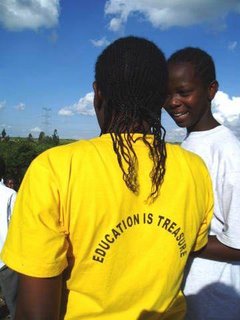
Education is Treasure
On 9 January 2006, when the Bahati Haiku Poetry Club (nickname : The Bamboochas) was born, the members were immediately eager to advance and progress in haiku themselves, and to do this together with their colleagues in neighbouring schools. That very first day, the idea was born to host a Ginkoo (吟行) in May 2006 and to invite other schools to participate.
During the following weeks, the Bamboochas studied and practised haiku under their teacher, Patrick Wafula (Patrick Sensei) and enjoyed themselves thoroughly -- as their name implies. Once they reached the mid-term break, they set out to present the art of haiku to the neighbouring schools, all of which liked the idea and decided to set up their own haiku clubs :
Embakazi Secondary School - The Oaks
Brookfield Secondary School - The Spiders
St Matthew’s Secondary School - The Peacocks
Lorna Waddington High School - The Falcons
Each of these clubs chose a patron among the teachers and started writing haiku. During April and May 2006, they organised a series of mini-ginkoo, one by one, and invited representatives of the other haiku clubs to join them.
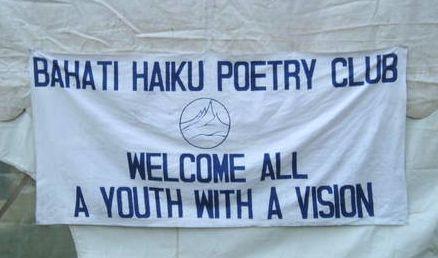
Photo 1 : Welcome sign at the Bahati tent.
They also made contact with the Japan Information & Culture Centre of the Embassy of Japan in Kenya and invited the Director, Mr Shinya Machida, to be Guest of Honour at the forthcoming Ginkoo. Mr Kiruri Gachie of the Japanese Department, Kenyatta University, was also invited, as were the Japanese community members resident in Kenya.
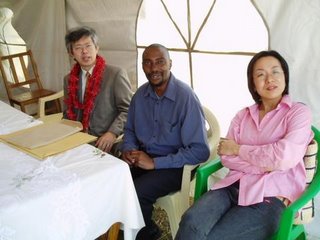
Photo 2 : Mr Shinyo Machida (Director of the Japan Information and Culture Centre), Mr Kiruri Gachie (Japanese Department of Kenyatta University), Ms Yooko Enomoto (Co-ordinator of the Japanese Association of Kenya).
A committee was formed in the local community, to take charge of the organisation and planning for the ginkoo, and the scouts were mobilised to contribute to the occasion. Almost 250 participants and guests were invited, including the local Chief and Sub District Officer as well as the Officer in Charge of the Police Post.
Finally, the day dawned to warm sunshine and great activity at Bahati School, as the tent was erected in front of the building and the haiku club members arrived in very good time, paper and pen in hand. Soon, many of the students were going through final rehearsals for their presentations, planned for the afternoon. I too was there early, enjoying the festive mood and the anticipation keenly felt by all.
xxxxxxxxxxxxxxxxxxxxxxxxxxxxx
The gathering started soon after 11.00 hrs, with the Kenyan and Japanese flags raised together by the Kenya Scouts, and the Kenyan National Anthem sung.
Photo 3 : Kenya and Japanese flags being raised by the Kenya Scouts
(Unfortunately we can not add all the photos here. Please click on the LINK to see the photos in the Bahati Club Photo Album. )
The Patrons introduced their respective haiku clubs -- and we finally heard why they had chosen their meaningful nicknames :
the Peacocks for the instant readiness of the bird, as well as its beauty,
the Oaks for the strength and durability of the tree,
the Falcons for the keen vision of the bird,
and the Bamboochas for the refreshment which their haiku would bring.
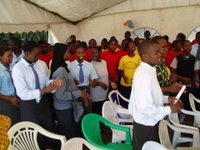
Photo 4 : The haiku clubs ready for action
There was a lot of cheering. Everyone was happy to be there, and to join with the members of the other clubs -- they had already become friends through sharing in the mini-ginkoo. This was the first time that the four schools had come together for an event, the first time that Bahati had hosted an event for the wider community, the first haiku ginkoo ever in Kenya (as far as we know!) -- and we even believe it may have been the biggest haiku event in the world on 27 May 2006. There was great joy in Bahati!
Photo 5 : Eager Falcons listening to the opening speeches
xxxxxxxxxxxxxxxxxxxxxxxxxxxxx
Mr Machida spoke to the gathering about the tradition of haiku in Japan, the history underlying it, and how it had continued into the present day, since it was grounded in the seasons and in nature. Even as it moved beyond Japan and into new territories, it was this link with nature and the seasons which made it adaptable to any culture and any country. Mr Machida was happy to see this first blossoming of haiku in Kenya, and wished the haiku clubs every success as they continued to learn and to practise.
As the Moderator of Kenya Saijiki, I then sent the students out to start their ginkoo. Observe keenly, and write no more than three haiku. The kigo (if used) could be from either the long rains, or from the cool dry season, as we were right between the two. The students then set out and, very soon, they had scattered in a 500 m radius around the school, heading off in different directions, often in small groups.
Bahati School is situated right next to Kayole River, which at this time was showing the effects of the long rains, with a lot of rubbish (including signs of sewage) washed up on the banks around the school. Several students devoted their attention to the river and its banks, all observing different aspects and drawing different conclusions. Thus, some of the poets observed the dirt and the smell, while others noticed how the deposits were helping nearby maize and bananas to grow!
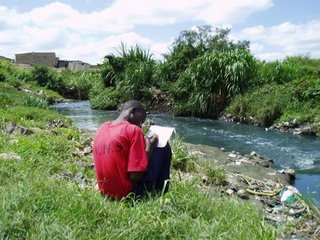
Photo 6 : Falcon deeply focused on Kayole River
xxxxxxxxxxxxxxxxxxxxxxxxxxxxx
After an hour, the students returned, and there was great excitement and a feeling of achievement. Everyone then selected their very best haiku of the day, writing it on a piece of colourful origami paper, and handing it over to the jury. Names were not included, only the haiku clubs were identified.
Photo 7 : Haiku submissions
While the jury retired to the cool courtyard of the school, the haiku clubs entertained the guests with lively presentations of poetry and drama, which they had rehearsed for the event. Sodas were enjoyed, bread and biscuits consumed, and much fun was had by all, while anticipation mounted.
Photo 8 : The jury in action
The jury needed quite some time to reach its conclusions on the winners -- luckily, we had a cool space within the school, where we deliberated and grouped the individual haiku entries with weights of water bottles, stones, spectacles and anything else that came to hand!
xxxxxxxxxxxxxxxxxxxxxxxxxxxxx
Before starting on the prize giving as such, Kiruri Gachie congratulated all the young poets on their work and the beautiful haiku they had written, and encouraged them to keep learning and practising. Being in touch with Kenya Saijiki and Worldkigo by internet would help them to exchange with poets in other countries, as well as learning from today’s masters.
The prize giving started with places 11 to 18 (in no particular order), followed by places 4 to 10 (again, in no particular order, with each poet receiving a Japanese cup). Then, the winners so far posed for a photograph :

Photo 9 : The winners of places 4 to 18
Finally, special prizes to the winners of places 3, 2 and 1 : a haiku notebook from Japan sent by Dr Gabi Greve, the Director of the World Haiku Club’s Worldkigo. A book or a painting went to each of the top three, as well as a Japanese cup and a book on Japan from Mr Machida. The winner of the first prize received a beautiful Ikebana calendar from the "Japanese Cultural Centre".
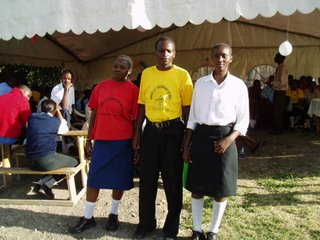
Photo 10 : The first three prizewinners, Grace Wanjau, Oseme Jeremiah and Miriam Nyambura
The atmosphere was wonderful -- more words of thanks were conveyed and received, and no one wanted to leave. Conversations continued, more photos were taken, but finally, the tent was dismantled and the students went home. There will certainly be more events -- the next one will most likely be a learning event, hosted by the Japanese Cultural Centre.
It was a beautiful day, and an unforgettable memory for most of us. The good wishes of Kenya Saijiki and Worldkigo were passed on and savoured, and we enjoyed being part of a world wide movement and being upheld by world wide good wishes.
Congratulations to everyone -- Bamboochas, Falcons, Oaks and Peacocks, as well as the organising committee -- and we look forward to welcoming the Spiders with us next time!
Isabelle Prondzynski
!!! Please click here to read the greetings from Gabi Greve and Sakuo Nakamura !!!
. Read short biographies of the winners of this contest .
*****************************
HAIKU
The prize winning haiku were as follows :
(Japanese by Nakamura Sakuo)
1.
strong and healthy maize
due to sewage nutrients --
very green colour
-- Grace Wanjau (Falcons)
唐黍や汚水で育つ青々と
tookibi ya osui de sodatsu aoao to
Photo 11 : Haiku student observing Kayole River
2.
a green insect
crawling in green grasses
sucking green sap
-- Oseme Jeremiah (Bamboochas)
青虫や 青葉を這って 青汁チュウ
aomushi ya aoba o hatte aojiru chu~
3.
goats and cows
scattered all over the place
grazing up and down
-- Miriam Nyambura (Bamboochas)
山羊羊 散りて草食み 上下へ
yagi to ushi chirite kusa hami ue shita e
4. - 10. (in alphabetical order of author name)
happy looking child
eats fleshy avocado --
no hunger at last
-- Cyprian Awino (Bamboochas)
幸せな 子 アボガド食べる 飢えは無し
shiawase na ko abocado taberu ue wa nashi
along the river bank
always green butterflies pounce
happily on cool grass
-- Gideon Gichamba (Peacocks)
cool, calm afternoon --
group of students crouch over
the grass for a bed
-- Kennedy Odhiambo (Bamboochas)
steps up and down
up the hills down the valleys
trying to observe
-- Olande E. Nancy (Oaks)
Photo 12 : Haiku students observing and writing
young African girl
looking confused
cutting kales
-- Ouko Hellen (Falcons)
rain has ended
footprints remain dry on the paths
kids stumble and fall
-- Raymond Otieno (Bamboochas)
Photo 13 : Children stuck in a dried rut (picture taken same day)
Kayole river
flooded with sewage
ugh! bad odour
-- Samuel Mwangi (Falcons)
11. - 18. (in alphabetical order of author name)
coloured petals
sprung like mushrooms
Njeri get decoration
-- Bonface Mutua (Falcons)
green turns to grey
crops mature as plants shed
as sun shines
-- David Wandera (Bamboochas)
dried up lips
thirsty throats in hotels
babies barefooted
-- Deborah Mocheche (Bamboochas)
bidens pilosa
growing taller and taller
shining everywhere
-- Felix Muyao (Bamboochas)
under the shade
people are squeezed
loosening their clothes
-- Lameck Odhiambo (Bamboochas)
"ten, ten, jeans!"
a man selling pants
they are so big
-- Mercy Keago (Falcons)
dust on shoes
as people walk down and up
along Soweto slum
-- Sammy Opagala (Bamboochas)
healthy bananas
using sewage manure --
very attractive
-- Samson Munga (Falcons)

Photo 14 : Closing the Ginkoo
*****************************
Related Entries
***** Bahati Haiku Poetry Club
BAHATI HAIKU POETRY CLUB, Records of all Haiku Collections
Look at the Bahati Haiku Poetry Club Photo Album
*****************************
THE KENYA SAIJIKI
Please send your contributions to
Gabi Greve / Isabelle Prondzynski
worldkigo .....
Back to the WHC Worldkigo Index






11 comments:
What a treat! Great energy coming over!
Thanks to all of you and keep going!
A friend from New Zealand !!!!
...................................
Some extra haiku by Patrick sensei, right after the Ginko:
Isabelles's small seed
spreading over Soweto
changing atittudes
white and black faces
expressing the same message
haiku unites
the children turned up
in red grey and yellow colours
the Kenyan ginkoo
http://groups.yahoo.com/group/kenyasaijiki/message/143?l=1
Thank you so much, Patrick sensei, for all your efforts in this event!
GABI
::::::::::::::::::::::::::::::::::::::::::::::::::::::::::::::::::::::
Thank you for sending this information!
I will be going to my first ginko this weekend and don't know what to expect.
S. from America
Dear Gabi san
Great thanks for reporting this Kenyan haiku event ! Please convey my congratulations to Isabelle san, Patrick sensei, and the young participants.
For long I had in my mind to introduce haiku to school children around here. This will give me the inspiration and courage to do the same.
sincerely
narayanan
. Narayanan Haiku .
.................................
Thank you, Narayanan san, for your kind words. I sure hope the kids in India will have the same fun as here!
GABI
::::::::::::::::::::::::::::::::::::::::::::::::::::::::::::::::::::::
Good going Isabelle! What a wonderful project! And the haiku were so astute. Of course, I liked No. 3, Miriam Nyambura's the best:)
Amy
The second Haiku by Patrick is really uniting nations through Haiku- let them enjoy!
A. from India
::::::::::::::::::::::::::::::::::::::::::::::::::::::::::::::::::::::
Dear Gabi
I worked 9 years in Kenya, mainly up-country, so was delighted
to see such an active haiku group. There were many fine verses
among the winners, the first two notable.
the birth came
before they reached the clinic
so they all went back
Dick
...................................
Thanks so much for your comments!
GABI
::::::::::::::::::::::::::::::::::::::::::::::::::::::::::::::::::::::
Felicitations.. C'est vraiment très impressionant… ma préfèrence va à celui-ci … pour le up and down
goats and cows
scattered all over the place
grazing up and down
JD
it is quite a surprise to see how the japanese haiku landscape becomes kenyan...it would be wonderful (and striking) to see those poems translated into japanese!!! (and it would be still more delightful to be able to contemplate the faces of the japanese reading them)...
-- from hr in tokyo
Thank you, hr san, for your comments.
We will try and translate some into Japanese!
Gabi Greve
. Translating Haiku .
::::::::::::::::::::::::::::::::::::::::::::::::::::::::::::::::::::::
I have been following these developments in Kenya for some time now and am delighted to see such a display of talent and enthusiasm. A big round of applause for your 1-st ginkoo...
Greetings from Romania,
Cristian Mocanu
Post a Comment